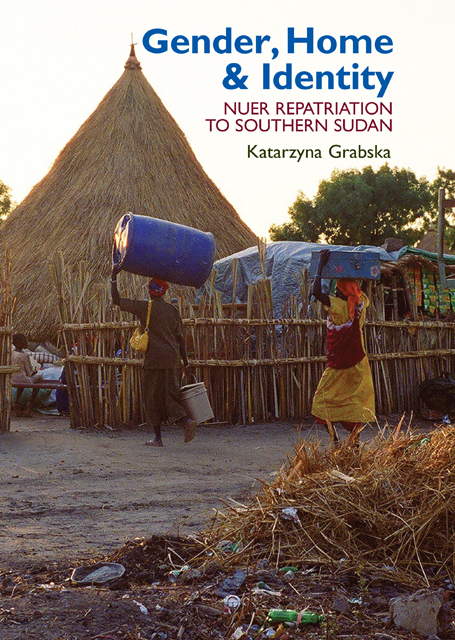Book contents
- Frontmatter
- Contents
- List of Maps and Photographs
- Preface
- Acknowledgements
- Glossary of Nuer Terms
- Acronyms
- 1 Returnee Dilemmas: Dangerous Trousers and Threatening Mini-skirts
- 2 Jiom – Season of Fighting and Running: Conflict, Mobility, Gender
- 3 Mai – Season of Displacement: Becoming ‘Modern’ in Kakuma
- 4 Rwil – Season of ‘Returns’
- 5 Season of Settling-in: Land and Livelihoods
- 6 Tot – Gendered Emplacement Identities, Ideologies and Marriage
- 7 Returnees as Visitors and the Nuer Community: Where Do We Go From Here?
- Epilogue
- Bibliography
- Index
- Eastern African Studies
2 - Jiom – Season of Fighting and Running: Conflict, Mobility, Gender
Published online by Cambridge University Press: 24 February 2023
- Frontmatter
- Contents
- List of Maps and Photographs
- Preface
- Acknowledgements
- Glossary of Nuer Terms
- Acronyms
- 1 Returnee Dilemmas: Dangerous Trousers and Threatening Mini-skirts
- 2 Jiom – Season of Fighting and Running: Conflict, Mobility, Gender
- 3 Mai – Season of Displacement: Becoming ‘Modern’ in Kakuma
- 4 Rwil – Season of ‘Returns’
- 5 Season of Settling-in: Land and Livelihoods
- 6 Tot – Gendered Emplacement Identities, Ideologies and Marriage
- 7 Returnees as Visitors and the Nuer Community: Where Do We Go From Here?
- Epilogue
- Bibliography
- Index
- Eastern African Studies
Summary
‘Which Wars Do You Want Me To Talk About?’: Narratives Of Wars On a hot afternoon in March 2007, I was sitting in a luak (cattle byre) watching Nyariek’s mother grinding sorghum and cooking walwal (sorghum porridge). Nyariek, a 16-year-old girl whom I’d met in Kakuma, had recently returned to southern Sudan. When I bumped into her in Lϵr she invited me to visit her mother, whom she had not seen since leaving for Kenya in 2001. After travelling by an old mini-bus and walking for three hours through dusty savannah, we reached Maper, Nyariek’s birthplace. Inside the luak I listened to women narrate stories of war and displacement. ‘Which war do you want me to talk about?’ asked Nyariek’s mother, who had stayed in Maper throughout the conflicts:
They were all here; they came like wind [jiom]. We suffered a lot here because of oil. First the Arabs came and this was the war of the government [koor kume]. Then the Dinka started fighting the Nuer and people had to run from one place to another. Then the Nuer started fighting each other. These conflicts were different because of [the use of] guns. The mothers stayed with children behind in the bush. Many men were killed and others ran away. Women were killed, and if you were lucky, you were taken as a wife by the enemy. Houses were burnt and cows and goats were all taken away. There was a lot of suffering and running.
Stories of war, violence, running and survival were a common narrative of many southern Sudanese I met in Egypt, and thereafter in Kenya and southern Sudan. The wind that came from behind the luak, as predicted by the most influential Nuer prophet Ngundϵng,1 brought the turmoil of the second civil war to the Sudanese, and to the Nuer in particular, causing traumatic changes in their lives. Although the first civil war devastated much of southern Sudan, including the communities of eastern Nuer bordering Ethiopia, severe flooding in the Western Upper Nile region spared the western Nuer from the disastrous consequences of the conflict experienced elsewhere.
- Type
- Chapter
- Information
- Gender, Home and IdentityNuer Repatriation to Southern Sudan, pp. 28 - 63Publisher: Boydell & BrewerPrint publication year: 2014



